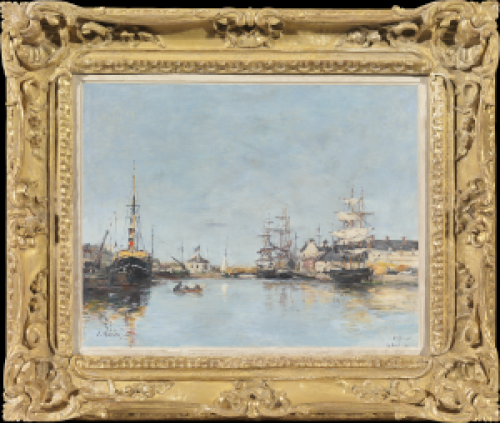HENRI FANTIN-LATOUR
Grenoble 1836 - 1904 Buré
Ref: BV 201
Pommes dans un panier sur la table
Signed and dated upper right: Fantin . '88
Oil on canvas: 17¼ x 22 1/8 in / 43.8 x 56.2 cm
Frame Size: 25 x 30¼ x 3 inches
In an antique Louis XIV carved and gilded frame
Provenance:
Mrs Edwin Edwards, London, acquired directly from the artist Hôtel Drouot, Paris, 21st February 1913, lot 21 Gustave Tempelaere, Paris Félix Gérard, Paris Rosenberg Collection, Europe Christie’s New York, 15th November 1989, lot 365 Private collection, acquired at the above sale;
Christie’s New York, 2nd November 1993, lot 17 The Lefevre Gallery, London Private collection, Europe, acquired from the above;
Sotheby’s London, 4th February 2003, lot 5; Richard Green, London, 2003;
Private collection, USA
Exhibited:
Paris, Palais de L’école Nationale des Beaux-Arts, Exposition de l’oeuvre de Henri Fantin-Latour, 1906, no.109
Literature:
Mme Fantin-Latour, Catalogue de l'oeuvre complet de Fantin-Latour 1849-1904, Paris 1911, p.140, no.1340
To be included in the forthcoming catalogue raisonné of the paintings and pastels of Henri Fantin-Latour currently being prepared by Galerie Brame & Lorenceau.
Henri Fantin-Latour had a profound understanding of the tradition of European still life painting, copying works in the Louvre and being particularly influenced by the exquisite compositions of Jean-Baptiste-Siméon Chardin (1699-1779). His early still life paintings from the 1860s were complex, with arrangements of flowers, fruit and ceramics on table tops. In the following decades he greatly simplified his compositions and began to specialise in flower paintings, particularly of roses. However, as this arresting work shows, he continued to make vey fine fruit still lifes into the 1880s. Fantin-Latour employs his characteristic brown, gently textured background, against which the yellow, green and red of the apples stand out with sculptural solidity. The composition is restrained, yet beautifully balanced, and each apple is individualised in texture, form and colour.
The first owner of this work was Ruth Edwards, widow of Edwin Edwards (1823-1879), an English lawyer and amateur artist whom Fantin had met through Whistler on his visit to London in 1861. Edwin and Ruth acted as his agents in Britain, disseminating an enthusiasm for Fantin’s work among the garden-loving nation. The Edwardses also shared with Fantin a passion for music, particularly Wagner; Mrs Edwards was a fine pianist.
HENRI FANTIN-LATOUR
Grenoble 1836 - 1904 Buré
Henri Fantin-Latour painted sensitive portraits and subject pictures, but is chiefly renowned today for his outstanding flower still lifes, which were especially popular in England and America. He was born in Grenoble in 1836, the son of the portrait painter Jean-Théodore Fantin-Latour and his Russian wife Helène de Naidenoff. Henri studied with his father, with Lecoq de Boisbaudran, and in Courbet’s studio in 1861. He copied works in the Louvre, gaining a lifelong respect for the European Old Master tradition, especially Titian’s use of colour and Chardin’s painterly still-lifes. Fantin met Manet in 1857 and exhibited at the 1863 Salon des Refusés, but eschewed the first Impressionist exhibition of 1874, preferring the Salon, where he exhibited from 1861 to 1899. Although on good terms with the Impressionists, he was wary of the excesses of the avant-garde.
In 1858 Fantin encountered Whistler and subsequently made four trips to England. On his second visit, in 1861, he was taught to etch by Whistler’s brother-in-law Seymour Haden and met Ruth and Edwin Edwards, who were to become Fantin’s agents in England, building up a market for his still-lifes in that country. Fantin executed a series of incisive self-portraits in the second half of the 1850s. From 1864 he produced a series of group portraits which serve as Fantin’s ‘professions of faith’ in contemporary art and culture. They depict writers and artists in works such as Studio in the Batignolles (Musée d’Orsay, Paris), shown at the Salon in 1870, which brings together Zola, Monet and Renoir in the studio of Manet.
Fantin’s flower still lifes combined harmony of composition and acute observation of the structure of plants with rich, painterly brushwork. He preferred to paint his blooms in the studio against a plain background which emphasized their tranquil, poetic beauty. Jacques-Emile Blanche wrote: ‘Fantin studied each flower, each petal, its grain, its tissue, as if it were a human face’. In 1876 he married his pupil Victoria Dubourg (1840-1926). The couple spent their summers at Victoria’s family home at Buré in Normandy, where the abundant garden inspired Fantin to more informal and lavish still lifes.
A lifelong music lover (his wife was a fine musician), Fantin was inspired by Berlioz and Wagner, whose lush Romanticism and complex, mythic themes provided subjects for the Symbolist aspect of his art. His lithographs of scenes from The Ring were reproduced in Adolphe Jullien’s biography of Richard Wagner (1888). Henri Fantin-Latour died at Buré in 1904.































